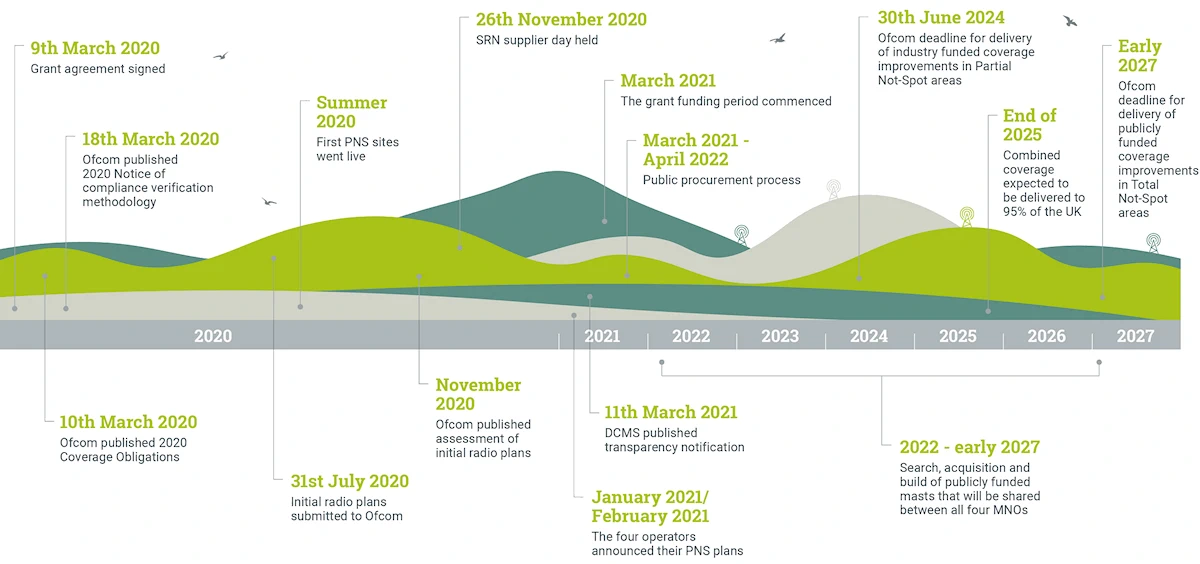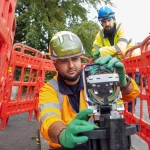Rural Coalition Reiterates Concerns Over 4G Mobile Rollout to UK Gov

A coalition of 46 signatories (mostly in Scotland), including various outdoor conservation organisations, community councils / trusts and landowners, have again called on the UK government to avoid “needless damage to large areas of some of the wildest places” by reconsidering the rural expansion of 4G (broadband) mobile masts under the £1bn Shared Rural Network project.
The industry-led SRN project with EE (BT), Vodafone, Three UK and O2 (Virgin Media) – supported by £501m of public funding and £532m from operators – involves both the reciprocal sharing of existing masts in certain areas and the demand-led building and sharing of new masts in others between the operators (MNO). The target is to extend geographic 4G coverage (aggregate) to 95% of the UK by the end of 2025, which falls to 84% when only considering the areas where you’ll be able to take 4G from all providers. Future 5G upgrades will also benefit from the new infrastructure.
The SRN includes two key targets. The first involves the delivery of industry funded coverage improvements in Partial Not-Spot (PNS) areas (i.e. areas that receive coverage from at least one operator, but not all), which needed to be achieved by June 2024 – at this point 4G (mobile broadband) must cover 88% of the UK’s landmass (only Three UK appear to have missed this – here).
Advertisement
The second target, which is the one that the aforementioned coalition has concerns about, involves tackling Total Not-Spot (TNS) areas by early 2027. Just to be clear, Ofcom’s licence obligations commit each individual operator to increase its 4G coverage to 88% of the UK’s landmass by June 2024 – rising to 90% by January 2027 – with these individual obligations supporting the overall target of 95% by December 2025.

The SRN largely only exists because many people and MPs were complaining about the UK’s patchy mobile coverage, which has long been noted to be particularly weak in rural areas. But not everybody is happy with the idea of erecting masts around the countryside, and that’s particularly true in Scotland, where 260 sites have been classified as TNS.
The coalition, which includes various organisations such as RSPB Scotland, the John Muir Trust, Mountaineering Scotland, Scottish Land & Estates, the National Trust for Scotland, Ramblers Scotland, and Woodland Trust Scotland, among others, have now written to the UK’s new Digital Infrastructure Minister, Sir Chris Bryant, and called on him to consider the environmental impact of the SRN.
Advertisement
The focus of all this seems to be on TNS areas, where the coalition claims that sites are “often selected mainly to provide landmass coverage and meet the geographical targets of the programme, rather than prioritising coverage for communities or transport routes.” This is worth investigating, but it should also be noted that mobile operators are commercial companies and will generally still seek to gain some return on their investment (i.e. improving rural coverage is not the most lucrative of exercises, but it usually does still bring something back).
Sarah-Jane Laing, CEO of Scottish Land and Estates, said:
“The SRN programme has been vital in improving mobile connectivity for many communities and businesses across Scotland, but it risks undermining that achievement by placing expensive masts in locations where there is no demand for them and where the infrastructure will be a blot on the landscape – potentially irreparably damaging these special, often untouched, places.
We are urging the Government to undertake a review of the TNS programme and take a pragmatic approach rather than simply pushing forward in order to achieve ill-devised targets.”
In keeping with all this, Mountaineering Scotland have produced an interactive map and list of active SRN planning proposals (here). But if any of this sounds familiar, then that’s because the same coalition raised similar concerns toward the end of last year (here). The new approach is thus perhaps an attempt to test the waters and see whether the new Labour-led government is more receptive to their concerns.
However, the new government has already committed to making a “renewed push to fulfil the ambition of full gigabit and national 5G coverage by 2030” (i.e. broadly supporting the previous government’s targets), and have similarly moved to cut more red tape via reform of the planning system. Suffice to say that we do not expect too many changes from the Government on this side of things.
Mark is a professional technology writer, IT consultant and computer engineer from Dorset (England), he also founded ISPreview in 1999 and enjoys analysing the latest telecoms and broadband developments. Find me on X (Twitter), Mastodon, Facebook, BlueSky, Threads.net and Linkedin.
« Full Fibre UK Broadband Network Community Fibre Top 300k Customers






















































Next week: Mountaineering Scotland dismayed that people involved in an accident were unable to call for help using their mobile phones.
Seriously though — this infrastructure is pretty minor in the grand scheme of things, especially if the masts are taller (covering a larger area with fewer masts). This very much feels like a storm in a teacup.
Exactly what was thinking. Lone estate/farm workers, walkers, climbers need the option of raising the alarm and seeking help. With 3g being switched off and 2g to follow, good phone coverage is important for safety, its not about being able to video stream in the middle of nowhere.
Rural communities and residents already face huge disadvantages in digital connectivity with rubbish fixed broadband and little to no mobile coverage. These areas also have the highest likelihood of facing extended power outages, meaning the PSTN retirement brings another issue. Not to mention these ‘wilderness’ areas are essential economic income areas through adventure tourism and exploration. Farming, crofting, country estates – these all need access to connectivity to maintain their business and industries in the modern world. If this coalition gets its way, rural communities will die out, the rural economy will be devastated, and there is a real risk to life if hill walkers cant dial 999.
I love the great outdoors and absolutely agree there needs to be sensitivity in this – but it is absolutely essential to improve digital connectivity wholesale, especially in ‘wilderness’ areas.
Ugh, some of those consultations linked by Mountaineering Scotland have been absolutely bombed with objections.
It’s a shame, because I was recently in an area that would be covered by one of these proposed masts. It was an outdoor event. If we’d needed to contact the emergency services, I wouldn’t have had signal.
It’s good to see consensus above, and yes you should write a short favourable response in consultations if you have the time.
The idea that in modern Britain there should not be nationwide coverage is ridiculous. Not to mention a telegraph pole is one of least invasive forms of national infrastructure.
After decades of Planning objections to new build infrastructure I can’t believe that no Network investors have asked their suppliers to provide the equipment with camouflage paint to minimise the visual impact of it.
Yes, the vegetation changes colour through the seasons but minimise doesn’t mean make invisible rather brake up the shape outlines from straight edges and rectangular to fit the observed plant or rock shapes..
I have seen a number of masts planned in the last couple of years which are proposing exactly this. Telecoms masts painted to blend in with the landscape, even some that are ‘disguised’ as a weird looking tree. Applications in the Cairngorms National Park area for example appear to add these measures into their plan. Despite this, the people who will moan, will moan regardless. I’ve seen objectors move from aesthetics, to wildlife, to trees, to ‘the health risks of 5G.’ As soon as you provide evidence their objection is unfounded, they move on to another reason. This is why planning applications take so long.
Toughen process, legislate to prioritise safety to access services and force rural collaboration between operators to invest, install and operate or be penalised.
This nonsense has gone on long enough.
All technology is proven, hands need to be twisted. Right now.
Did we read the same article? The problem was not the mobile companies. Unless the hands you are twisting are the objectors, which is a weird thing to write.
You are quite right Michael. I was not clear. It is the hand of governance I meant to imply needs twisting, to get coverage in place. There have been too many incidents endangering life.